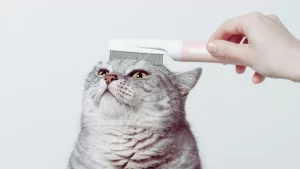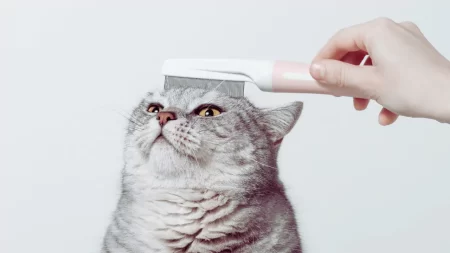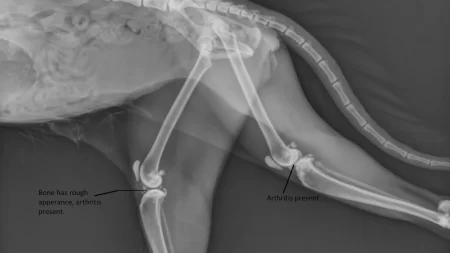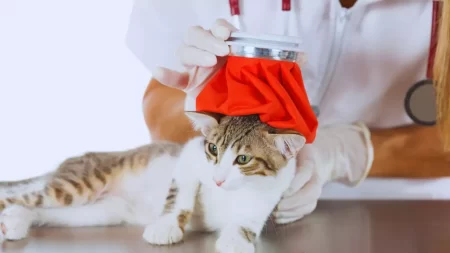Cats are natural hunters and carnivores, and their diet in the wild consists mainly of raw meat, bones, organs, and fish.
Many cat owners wonder if they can replicate this diet at home and feed their cats raw food instead of commercial kibble or canned food.
What are the benefits and risks of a raw diet for cats? How can you make sure your cat gets all the nutrients they need from raw food? Is a raw diet right for your cat?
In this article, we will answer these questions and more, based on the latest scientific research and expert advice.
Understanding Raw Diets for Cats
What Is A Raw Diet For Cats?
A raw diet for cats is feeding them uncooked animal products, such as muscle meat, organ meat, bones, and fish. This type of food is sometimes called the “BARF” diet, which stands for “bones and raw food” or “biologically-appropriate raw food”. A raw diet may have benefits for cats’ health, such as supporting their teeth, gums, digestion, skin, coat, and stamina.
Reasons Why Cat Owners Choose A Raw Diet
Some of the reasons why cat owners choose to feed their cats a raw diet are:
- To provide a more natural and species-appropriate diet for their cats.
- To avoid artificial additives, preservatives, fillers, grains, or by-products that may be found in some commercial cat foods.
- To improve their cats’ health conditions, such as allergies, diabetes, obesity, urinary tract infections, or inflammatory bowel disease.
- To enhance their cats’ appearance, behavior, and quality of life.
Common Types Of Raw Foods For Cats
There are different ways to feed your cat a raw diet, depending on your preferences, budget, time, and availability. Some of the common types of raw foods for cats are:
- Homemade raw food: This involves preparing your own raw food recipes at home, using fresh or frozen ingredients that you buy from a butcher, a supermarket, or an online supplier. You will need to follow specific guidelines and recipes to ensure that your cat gets a balanced and complete diet that meets its nutritional needs. You will also need to practice proper food hygiene and storage to prevent bacterial contamination and spoilage.
- Commercial raw food: This involves buying ready-made raw food products from a pet store or an online supplier. These products may come in different forms, such as frozen blocks, patties, nuggets, or dehydrated pieces. You will need to thaw or rehydrate the food before feeding it to your cat. You will also need to check the label and ingredients to make sure that the product is suitable for your cat and meets its nutritional requirements.
- Raw feeding supplements: These are products that are designed to complement a raw diet by providing additional nutrients that may be lacking in raw food alone. These products may include vitamins, minerals, amino acids, enzymes, probiotics, or omega-3 fatty acids. You will need to follow the instructions and dosage recommendations on the package to avoid over-supplementation or toxicity.
The Benefits of Raw Diets for Cats
A raw diet can provide several benefits for your cat’s health and well-being. Some of the benefits are:
Improved Digestion And Nutrient Absorption
Raw food is easier for cats to digest than cooked or processed food because it contains natural enzymes that help break down the food in the stomach and intestines.
Raw food also has higher moisture content than dry kibble or canned food which helps prevent dehydration and constipation.
Raw food can also enhance nutrient absorption because it contains more bioavailable forms of protein, fat, vitamins, and minerals than cooked or processed food.
Healthier Coat And Skin
Raw food can improve your cat’s coat and skin condition by providing essential fatty acids that help maintain skin moisture, elasticity, and barrier function.
Raw food can also reduce inflammation, itching, and irritation caused by allergies, parasites, or infections.
Raw food can also make your cat’s coat shinier, softer, and less prone to shedding.
Increased Energy And Vitality
Raw food can boost your cat’s energy and vitality by providing high-quality protein that supports muscle growth, strength, and repair.
Raw food can also stimulate your cat’s appetite, metabolism, and immune system by providing natural antioxidants, phytochemicals, and probiotics that help fight off diseases and infections.
Raw food can also enhance your cat’s mood, behavior, and cognitive function by providing essential amino acids that help produce neurotransmitters such as serotonin, dopamine, and acetylcholine.
Potential Weight Loss
Raw food can help your cat lose weight or maintain a healthy weight by providing fewer calories than cooked or processed food.
Raw food can also help regulate your cat’s blood sugar levels by providing low-glycemic carbohydrates that do not cause spikes or crashes in insulin levels.
Raw food can also help control your cat’s hunger and satiety by providing more protein and fiber that keep your cat feeling full longer.
Reduced Stool Odor And Volume
Raw food can reduce your cat’s stool odor and volume by providing more digestible ingredients that leave less waste in the colon.
Raw food can also reduce flatulence, diarrhea, or constipation by providing more balanced flora in the gut that helps prevent bacterial overgrowth or imbalance.
The Risks and Potential Health Issues of Raw Diets for Cats
A raw diet can also pose some risks and potential health issues for your cat if not done properly or safely. Some of the risks are:
Bacterial Contamination And Foodborne Illness
Raw food can be contaminated with harmful bacteria such as Salmonella, E. coli, Campylobacter, or Listeria which can cause serious illness or death in cats or humans who handle or consume the food. To prevent bacterial contamination and foodborne illness, you should:
- Buy fresh or frozen ingredients from reputable sources that follow sanitary standards.
- Wash your hands, utensils, surfaces, and bowls before and after handling raw food.
- Thaw frozen food in the refrigerator or microwave, not on the counter.
- Refrigerate leftover food within two hours or discard it.
- Feed your cat in a separate area from other pets or humans.
- Monitor your cat for signs of illness such as vomiting, diarrhea, fever, lethargy, or loss of appetite.
- Consult your veterinarian if you suspect your cat has been infected with bacteria.
Nutritional Imbalances And Deficiencies
Raw food may not provide all the nutrients that your cat needs to stay healthy if not formulated correctly or supplemented adequately. Some of the nutrients that may be lacking in a raw diet are:
- Taurine: an essential amino acid that is vital for heart, eye, and brain function.
- Vitamin A: a fat-soluble vitamin that is important for vision, skin, and immune health.
- Vitamin B12: a water-soluble vitamin that is crucial for red blood cell production, nerve function, and metabolism.
- Calcium: a mineral that is essential for bone health, muscle contraction, and blood clotting.
- Phosphorus: a mineral that is necessary for energy production, cellular function, and acid-base balance.
- Iodine: a trace element that is required for thyroid hormone synthesis, regulation, and metabolism.
To prevent nutritional imbalances and deficiencies, you should:
- Follow reliable recipes and guidelines from experts who have experience with raw feeding.
- Use a variety of ingredients from different animal sources to provide a balanced amino acid profile.
- Include organ meats such as liver, kidney, or heart to provide vitamins A, B12, and other micronutrients.
- Include edible bones such as chicken necks, wings, or ribs to provide calcium, phosphorus, and other minerals.
- Use iodized salt or seaweed to provide iodine.
- Use supplements designed specifically for raw feeding to fill any gaps in nutrition.
- Check the label and ingredients of any commercial raw products to ensure they meet AAFCO standards.
- Monitor your cat’s blood work regularly to detect any signs of deficiency or excess.
Risk Of Bone Fractures Or Dental Injury
Raw bones can pose a risk of bone fractures or dental injury if they are too hard, large, or sharp for your cat to chew safely. Bone fragments can also get stuck in your cat’s mouth, throat, stomach, or intestines, causing obstruction, perforation, or infection.
To prevent bone fractures or dental injury, you should:
- Only feed raw bones that are soft, small, and edible for your cats, such as chicken necks, wings, feet, or quail bones.
- Never feed raw bones that are hard, large, or brittle for your cats, such as beef bones, pork bones, lamb bones, or cooked bones.
- Watch your cat closely when they are eating raw bones and remove any bone fragments that may be left behind.
- Check your cat’s mouth regularly for any signs of injury or infection.
- Contact your veterinarian immediately if you notice any symptoms of bone-related problems in your cat, such as choking, gagging, vomiting, diarrhea, blood in stool, abdominal pain, or lethargy.
Cost and Convenience
Raw food can be more expensive and less convenient than cooked or processed food, depending on the type and source of raw food you choose. Raw food can also take up more space in your freezer or refrigerator, and require more preparation time and effort than kibble or canned food.
To reduce the cost and inconvenience of raw food, you should:
- Compare prices and quality of different raw food suppliers, both online and offline.
- Buy raw food in bulk or on sale when possible, and store it properly to prevent spoilage.
- Use a raw cat food calculator to determine how much to feed your cat and how much it costs.
- Plan ahead and thaw or rehydrate raw food before feeding time.
- Use a food processor or grinder to make your own raw food grinds or patties.
- Use a dehydrator or oven to make your own raw food treats or jerky.
Making the Decision to Feed Your Cat a Raw Diet
Consulting With Your Veterinarian
Before you decide to feed your cat a raw diet, you should consult with your veterinarian to make sure that it is safe and suitable for your cat’s individual needs. Your veterinarian can help you:
- Assess your cat’s health status, age, breed, activity level, and medical history.
- Determine if your cat has any allergies, sensitivities, or special dietary requirements.
- Recommend a balanced and complete raw diet that meets your cat’s nutritional needs.
- Advise you on how to transition your cat from their current diet to a raw diet gradually and safely.
- Provide you with resources and support for raw feeding.
Researching Safe And Balanced Raw Food Options
If you decide to feed your cat a raw diet, you should do your research to find safe and balanced raw food options that suit your cat’s preferences and lifestyle. You should:
- Look for reputable raw food suppliers that follow high standards of quality, safety, and hygiene
- Read customer reviews and testimonials to get feedback from other raw feeders
- Check the ingredients and nutritional analysis of any commercial raw products to ensure they are appropriate for your cat
- Follow reliable recipes and guidelines from experts who have experience with raw feeding
- Use supplements designed specifically for raw feeding to fill any gaps in nutrition
Monitoring Your Cat’s Health And Adjusting The Diet As Necessary
Once you start feeding your cat a raw diet, you should monitor your cat’s health and adjust the diet as necessary to ensure optimal results. You should:
- Observe your cat’s appetite, energy level, behavior, and mood
- Check your cat’s weight, body condition score, coat condition, skin condition, and stool quality
- Schedule regular veterinary check-ups and blood tests to evaluate your cat’s health status
- Report any signs of illness or adverse reactions to your veterinarian immediately
- Experiment with different types of raw foods, proteins, textures, flavors, and portions to find what works best for your cat
Weighing The Potential Benefits And Risks
Ultimately, the decision to feed your cat a raw diet depends on weighing the potential benefits and risks of this feeding method. You should consider:
- The pros and cons of a raw diet for cats
- The cost and convenience of a raw diet for cats
- The availability and quality of raw food options for cats
- The safety and suitability of a raw diet for your cat’s individual needs
- The advice and support of your veterinarian
Conclusion
A raw diet can be a natural way to feed your feline friend, providing them with uncooked animal products that mimic their ancestral diet.
A raw diet may have benefits for cats’ health, such as improved digestion, nutrient absorption, coat condition, energy level, weight management, and stool quality.
However, a raw diet can also pose some risks and potential health issues for cats if not done properly or safely, such as bacterial contamination, foodborne illness, nutritional imbalances, deficiencies, bone fractures, or dental injury.
Therefore, before you decide to feed your cat a raw diet, you should consult with your veterinarian, research safe and balanced raw food options, monitor your cat’s health, and adjust the diet as necessary.
You should also weigh the potential benefits and risks of a raw diet for cats, and consider if it is the best choice for your cat’s individual needs, preferences, and lifestyle.
FAQs
Is a raw diet suitable for all cats?
A raw diet may not be suitable for all cats, especially those with medical conditions, allergies, or sensitivities. Consult your veterinarian before switching.
Can a raw diet cure existing health issues in cats?
A raw diet may not cure existing health issues in cats, but it may help prevent or manage some conditions, such as obesity, diabetes, or allergies.
Can kittens be fed a raw diet?
Yes, kittens can be fed a raw diet, as long as it is balanced and complete for their growth and development. Start with small and soft bones.
How can I ensure the safety of a raw diet for my cat?
You can ensure the safety of a raw diet for your cat by buying from reputable sources, practicing good hygiene, and following expert guidelines.
What are the alternative options to a raw diet?
Some alternative options to a raw diet are cooked homemade food, high-quality canned food, or freeze-dried or dehydrated food.







